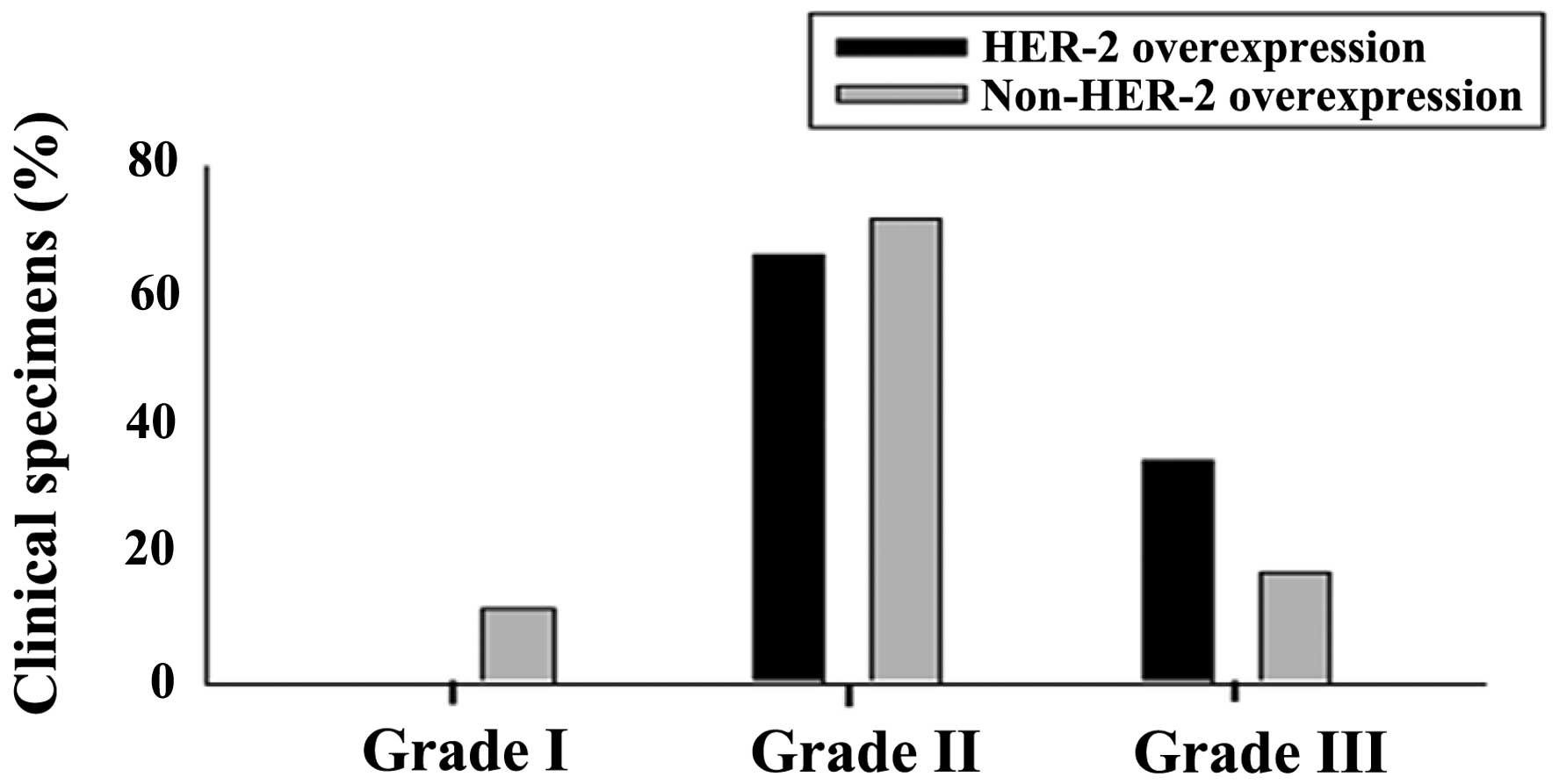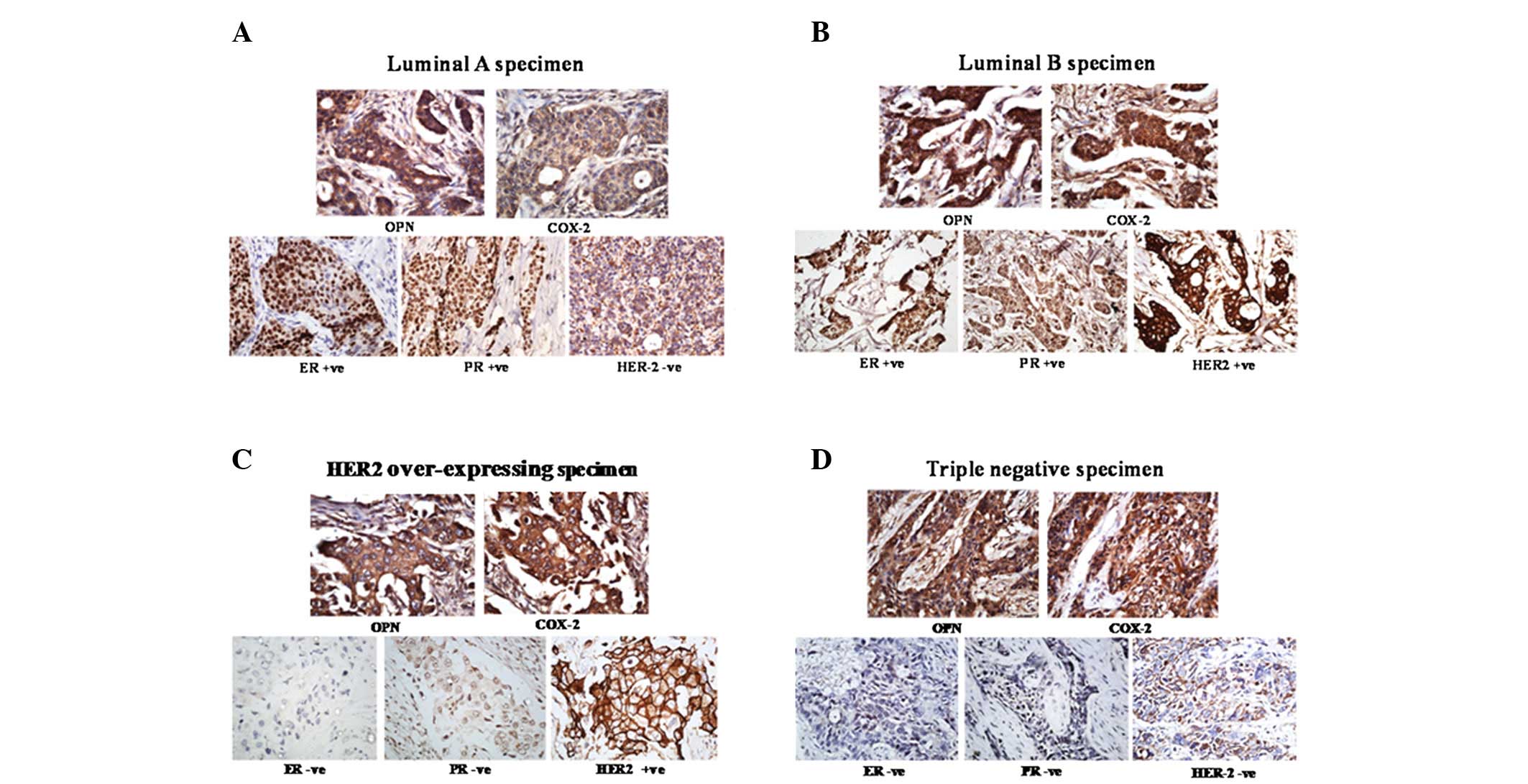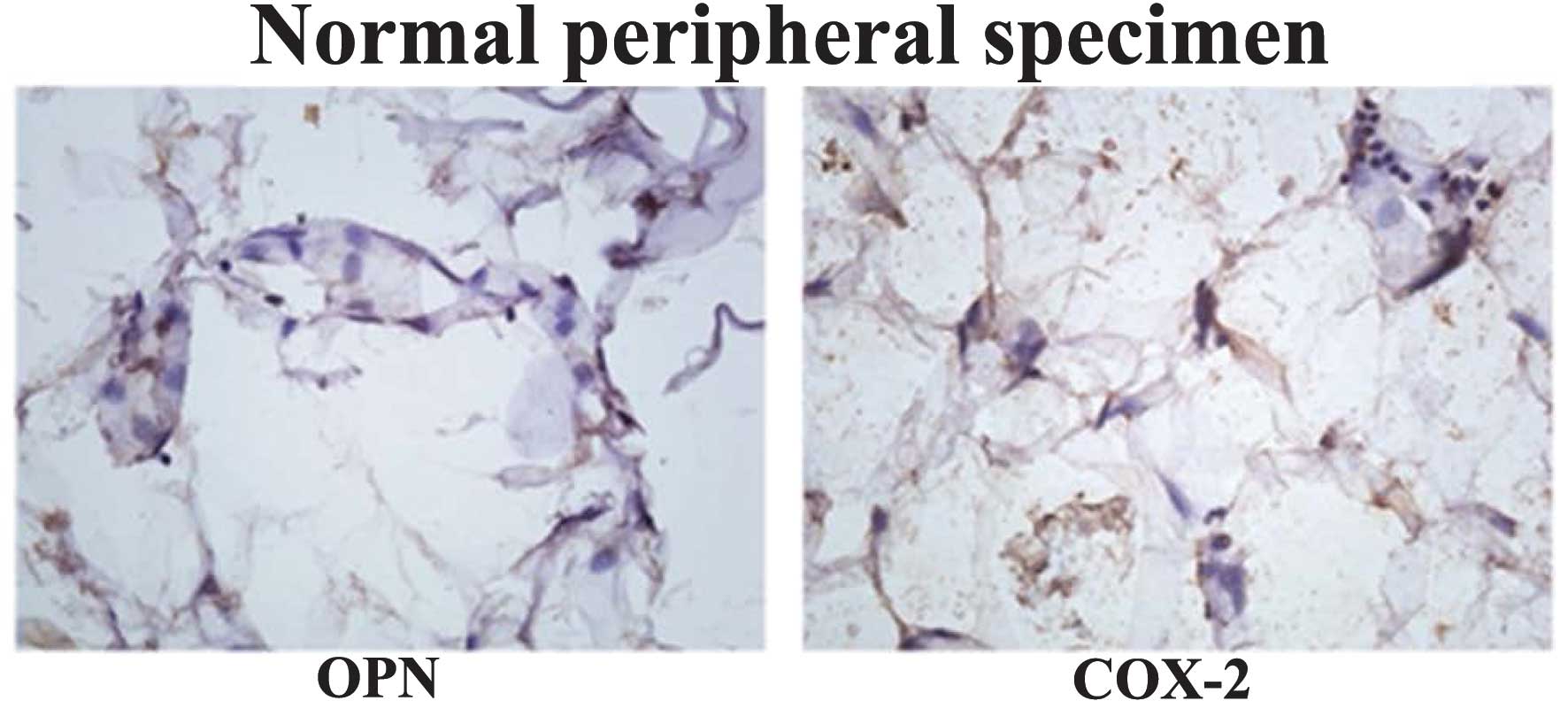|
1
|
Murthy NS, Chaudhry K, Nadayil D, Agarwal
UK and Saxena S: Changing trends in incidence of breast cancer:
Indian scenario. Indian J Cancer. 46:73–74. 2009. View Article : Google Scholar : PubMed/NCBI
|
|
2
|
Sengupta A: The emergence of the menopause
in India. Climacteric. 6:92–95. 2003. View Article : Google Scholar : PubMed/NCBI
|
|
3
|
Kapur P, Sinha B and Pereira BM: Measuring
climacteric symptoms and age at natural menopause in an Indian
population using the Greene Climacteric Scale. Menopause.
16:378–384. 2009. View Article : Google Scholar : PubMed/NCBI
|
|
4
|
Rangaswami H, Bulbule A and Kundu GC:
Osteopontin: role in cell signaling and cancer progression. Trends
Cell Biol. 16:79–87. 2006. View Article : Google Scholar : PubMed/NCBI
|
|
5
|
Liaw L, Birk DE, Ballas CB, Whitsitt JS,
Davidson JM and Hogan BL: Altered wound healing in mice lacking a
functional osteopontin gene (spp1). J Clin Invest. 101:1468–1478.
1998. View
Article : Google Scholar : PubMed/NCBI
|
|
6
|
Sodek J, Ganss B and McKee MD:
Osteopontin. Crit Rev Oral Biol Med. 11:279–303. 2000. View Article : Google Scholar
|
|
7
|
Jain S, Chakraborty G, Bulbule A, Kaur R
and Kundu GC: Osteopontin: an emerging therapeutic target for
anticancer therapy. Expert Opin Ther Targets. 11:81–90. 2007.
View Article : Google Scholar : PubMed/NCBI
|
|
8
|
Ahmed M, Behera R, Chakraborty G, et al:
Osteopontin: a potentially important therapeutic target in cancer.
Expert Opin Ther Targets. 15:1113–1126. 2011. View Article : Google Scholar : PubMed/NCBI
|
|
9
|
Rudland PS, Platt-Higgins A, El-Tanani M,
et al: Prognostic significance of the metastasis-associated protein
osteopontin in human breast cancer. Cancer Res. 62:3417–3427.
2002.PubMed/NCBI
|
|
10
|
Chakraborty G, Jain S, Behera R, Ahmed M,
Sharma P, Kumar V and Kundu GC: The multifaceted roles of
osteopontin in cell signaling, tumor progression and angiogenesis.
Curr Mol Med. 6:819–830. 2006. View Article : Google Scholar : PubMed/NCBI
|
|
11
|
Mirza M, Shaughnessy E, Hurley JK,
Vanpatten KA, Pestano GA, He B and Weber GF: Osteopontin-c is a
selective marker for breast cancer. Int J Cancer. 122:889–897.
2008. View Article : Google Scholar : PubMed/NCBI
|
|
12
|
Henry NL and Hayes DF: Uses and abuses of
tumor markers in the diagnosis, monitoring and treatment of primary
and metastatic breast cancer. Oncologist. 11:541–552. 2006.
View Article : Google Scholar : PubMed/NCBI
|
|
13
|
Clark GM: Prognostic and predictive
factors. Diseases of the Breast. Harris JR, Lippman ME, Morrow M
and Osborne CK: Lippinscott, Williams and Wilkins; Philadelphia:
pp. 489–514. 2000
|
|
14
|
Andre F and Pusztai L: Molecular
classification of breast cancer: implications for selection of
adjuvant chemotherapy. Nat Clin Pract Oncol. 3:621–632. 2006.
View Article : Google Scholar : PubMed/NCBI
|
|
15
|
Chandrasekharan NV and Simmons DL: The
cyclooxygenases. Genome Biol. 5:2412004. View Article : Google Scholar : PubMed/NCBI
|
|
16
|
Ramsay RG, Ciznadija D, Vanevski M and
Mantamadiotis T: Transcriptional regulation of cyclo-oxygenase
expression: three pillars of control. Int J Immunopathol Pharmacol.
16:S59–S67. 2003.PubMed/NCBI
|
|
17
|
Sarkar FH, Adsule S, Li Y and Padhye S:
Back to the future: COX-2 inhibitors for chemoprevention and cancer
therapy. Mini Rev Med Chem. 7:599–608. 2007. View Article : Google Scholar : PubMed/NCBI
|
|
18
|
Kis B, Snipes JA, Isse T, Nagy K and
Busija DW: Putative cyclooxygenase-3 expression in rat brain cells.
J Cereb Blood Flow Metab. 23:1287–1292. 2003. View Article : Google Scholar : PubMed/NCBI
|
|
19
|
Ristimäki A, Sivula A, Lundin J, et al:
Prognostic significance of elevated cyclooxygenase-2 expression in
breast cancer. Cancer Res. 62:632–635. 2002.PubMed/NCBI
|
|
20
|
Boland GP, Butt IS, Prasad R, Knox WF and
Bundred NJ: COX-2 expression is associated with an aggressive
phenotype in ductal carcinoma in situ. Br J Cancer. 90:423–429.
2004. View Article : Google Scholar : PubMed/NCBI
|
|
21
|
Shim V, Gauthier ML, Sudilovsky D, et al:
Cyclooxygenase-2 expression is related to nuclear grade in ductal
carcinoma in situ and is increased in its normal adjacent
epithelium. Cancer Res. 63:2347–2350. 2003.PubMed/NCBI
|
|
22
|
Costa C, Soares R, Reis-Filho JS, Leitão
D, Amendoeira I and Schmitt FC: Cyclo-oxygenase 2 expression is
associated with angiogenesis and lymph node metastasis in human
breast cancer. J Clin Pathol. 55:429–434. 2002. View Article : Google Scholar : PubMed/NCBI
|
|
23
|
Davies G, Salter J, Hills M, Martin LA,
Sacks N and Dowsett M: Correlation between cyclooxygenase-2
expression and angiogenesis in human breast cancer. Clin Cancer
Res. 9:2651–2656. 2003.PubMed/NCBI
|
|
24
|
Denkert C, Winzer KJ, Müller BM, et al:
Elevated expression of cyclooxygenase-2 is a negative prognostic
factor for disease free survival and overall survival in patients
with breast carcinoma. Cancer. 97:2978–2987. 2003. View Article : Google Scholar : PubMed/NCBI
|
|
25
|
Shim JY, An HJ, Lee YH, Kim SK, Lee KP and
Lee KS: Overexpression of cyclooxygenase-2 is associated with
breast carcinoma and its poor prognostic factors. Mod Pathol.
16:1199–1204. 2003. View Article : Google Scholar : PubMed/NCBI
|
|
26
|
Tan KB, Yong WP and Putti TC:
Cyclooxygenase-2 expression: a potential prognostic and predictive
marker for high-grade ductal carcinoma in situ of the breast.
Histopathology. 44:24–28. 2004. View Article : Google Scholar : PubMed/NCBI
|
|
27
|
Le Doussal V, Tubiana-Hulin M, Friedman S,
Hacene K, Spyratos F and Brunet M: Prognostic value of histologic
grade nuclear components of Scarff-Bloom-Richardson (SBR). An
improved score modification based on a multivariate analysis of
1262 invasive ductal breast carcinomas. Cancer. 64:1914–1921.
1989.
|
|
28
|
Greene FL, Page DL and Fleming ID: AJCC
Cancer Staging Manual. 6th edition. Springer; New York, NY: 2002,
View Article : Google Scholar
|
|
29
|
Allred DC, Clark GM, Elledge R, et al:
Association of p53 protein expression with tumor cell proliferation
rate and clinical outcome in node-negative breast cancer. J Natl
Cancer Inst. 85:200–206. 1993. View Article : Google Scholar : PubMed/NCBI
|
|
30
|
Jemal A, Siegel R, Xu J and Ward E: Cancer
statistics, 2010. CA Cancer J Clin. 60:277–300. 2010. View Article : Google Scholar
|
|
31
|
Glass AG, Lacey JV Jr, Carreon JD and
Hoover RN: Breast cancer incidence, 1980–2006: combined roles of
menopausal hormone therapy, screening mammography, and estrogen
receptor status. J Natl Cancer Inst. 99:1152–1161. 2007.
|
|
32
|
Ravdin PM, Cronin KA, Howlader N, et al:
The decrease in breast-cancer incidence in 2003 in the United
States. N Engl J Med. 356:1670–1674. 2007. View Article : Google Scholar : PubMed/NCBI
|
|
33
|
Carey LA, Perou CM, Livasy CA, et al:
Race, breast cancer subtypes, and survival in the Carolina Breast
Cancer Study. JAMA. 295:2492–2502. 2006. View Article : Google Scholar : PubMed/NCBI
|
|
34
|
Dolled-Filhart M, Rydén L, Cregger M,
Jirstrom K, Harigopal M, Camp RL and Rimm DL: Classification of
breast cancer using genetic algorithms and tissue microarrays. Clin
Cancer Res. 12:6459–6468. 2006. View Article : Google Scholar : PubMed/NCBI
|
|
35
|
Liu R, Wang X, Chen GY, et al: The
prognostic role of a gene signature from tumorigenic breast-cancer
cells. N Engl J Med. 356:217–226. 2007. View Article : Google Scholar : PubMed/NCBI
|
|
36
|
Sorlie T, Tibshirani R, Parker J, et al:
Repeated observation of breast tumor subtypes in independent gene
expression data sets. Proc Natl Acad Sci USA. 100:8418–8423. 2003.
View Article : Google Scholar : PubMed/NCBI
|
|
37
|
Sørlie T, Perou CM, Fan C, et al: Gene
expression profiles do not consistently predict the clinical
treatment response in locally advanced breast cancer. Mol Cancer
Ther. 5:2914–2918. 2006.
|
|
38
|
Van de Vijver MJ, He YD, van’t Veer LJ, et
al: A gene-expression signature as a predictor of survival in
breast cancer. N Engl J Med. 347:1999–2009. 2002.
|
|
39
|
Wang Y, Klijn JG, Zhang Y, et al: Gene
expression profiles to predict distant metastasis of
lymph-node-negative primary breast cancer. Lancet. 365:671–679.
2005. View Article : Google Scholar : PubMed/NCBI
|
|
40
|
Kreike B, van Kouwenhove M, Horlings H,
Weigelt B, Peterse H, Bartelink H and van de Vijver MJ: Gene
expression profiling and histopathological characterization of
triple-negative/basal-like breast carcinomas. Breast Cancer Res.
9:R652007. View
Article : Google Scholar : PubMed/NCBI
|
|
41
|
Slamon DJ, Clark GM, Wong SG, Levin WJ,
Ullrich A and McGuire WL: Human breast cancer: correlation of
relapse and survival with amplification of the HER-2/neu oncogene.
Science. 235:177–182. 1987. View Article : Google Scholar : PubMed/NCBI
|
|
42
|
Tsuda H, Hirohashi S, Shimosato Y, et al:
Correlation between long-term survival in breast cancer patients
and amplification of two putative oncogene-coamplification units:
hst-1/int-2 and c-erbB-2/ear-1. Cancer Res. 49:3104–3108.
1989.PubMed/NCBI
|

















